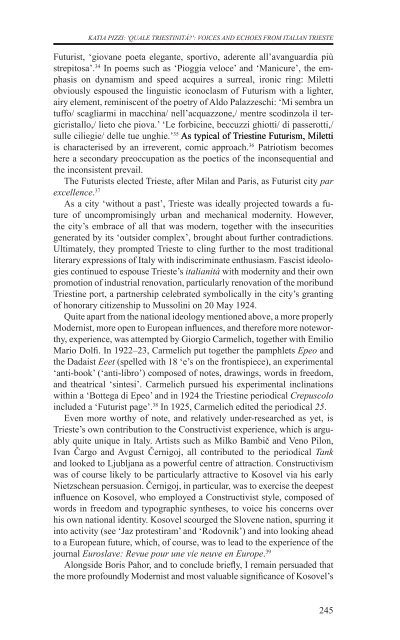razprave (pdf) - Društvo za primerjalno književnost - ZRC SAZU
razprave (pdf) - Društvo za primerjalno književnost - ZRC SAZU
razprave (pdf) - Društvo za primerjalno književnost - ZRC SAZU
- No tags were found...
Create successful ePaper yourself
Turn your PDF publications into a flip-book with our unique Google optimized e-Paper software.
katia pizzi: 'QUALE TRIESTINITÀ?': VOICES AND ECHOES FROM ITALIAN TRIESTEFuturist, ‘giovane poeta elegante, sportivo, aderente all’avanguardia piùstrepitosa’. 34 In poems such as ‘Pioggia veloce’ and ‘Manicure’, the emphasison dynamism and speed acquires a surreal, ironic ring: Milettiobviously espoused the linguistic iconoclasm of Futurism with a lighter,airy element, reminiscent of the poetry of Aldo Palazzeschi: ‘Mi sembra untuffo/ scagliarmi in macchina/ nell’acquazzone,/ mentre scodinzola il tergicristallo,/lieto che piova.’ ‘Le forbicine, beccuzzi ghiotti/ di passerotti,/sulle ciliegie/ delle tue unghie.’ 35 As typical of Triestine Futurism, Milettiis characterised by an irreverent, comic approach. 36 Patriotism becomeshere a secondary preoccupation as the poetics of the inconsequential andthe inconsistent prevail.The Futurists elected Trieste, after Milan and Paris, as Futurist city parexcellence. 37As a city ‘without a past’, Trieste was ideally projected towards a futureof uncompromisingly urban and mechanical modernity. However,the city’s embrace of all that was modern, together with the insecuritiesgenerated by its ‘outsider complex’, brought about further contradictions.Ultimately, they prompted Trieste to cling further to the most traditionalliterary expressions of Italy with indiscriminate enthusiasm. Fascist ideologiescontinued to espouse Trieste’s italianità with modernity and their ownpromotion of industrial renovation, particularly renovation of the moribundTriestine port, a partnership celebrated symbolically in the city’s grantingof honorary citizenship to Mussolini on 20 May 1924.Quite apart from the national ideology mentioned above, a more properlyModernist, more open to European influences, and therefore more noteworthy,experience, was attempted by Giorgio Carmelich, together with EmilioMario Dolfi. In 1922–23, Carmelich put together the pamphlets Epeo andthe Dadaist Eeet (spelled with 18 ‘e’s on the frontispiece), an experimental‘anti-book’ (‘anti-libro’) composed of notes, drawings, words in freedom,and theatrical ‘sintesi’. Carmelich pursued his experimental inclinationswithin a ‘Bottega di Epeo’ and in 1924 the Triestine periodical Crepuscoloincluded a ‘Futurist page’. 38 In 1925, Carmelich edited the periodical 25.Even more worthy of note, and relatively under-researched as yet, isTrieste’s own contribution to the Constructivist experience, which is arguablyquite unique in Italy. Artists such as Milko Bambič and Veno Pilon,Ivan Čargo and Avgust Černigoj, all contributed to the periodical Tankand looked to Ljubljana as a powerful centre of attraction. Constructivismwas of course likely to be particularly attractive to Kosovel via his earlyNietzschean persuasion. Černigoj, in particular, was to exercise the deepestinfluence on Kosovel, who employed a Constructivist style, composed ofwords in freedom and typographic syntheses, to voice his concerns overhis own national identity. Kosovel scourged the Slovene nation, spurring itinto activity (see ‘Jaz protestiram’ and ‘Rodovnik’) and into looking aheadto a European future, which, of course, was to lead to the experience of thejournal Euroslave: Revue pour une vie neuve en Europe. 39Alongside Boris Pahor, and to conclude briefly, I remain persuaded thatthe more profoundly Modernist and most valuable significance of Kosovel’s245
















